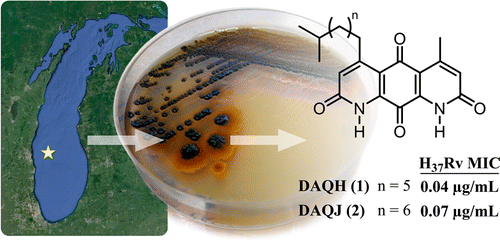Turning to freshwater sources to fight drug-resistant tuberculosis, other infections

The discovery of antibiotics produced by soil fungi and bacteria gave the world life-saving medicine. But new antimicrobials from this resource have become scarce as the threat of drug resistance grows. Now, scientists have started mining lakes and rivers for potential pathogen-fighters, and they've found one from Lake Michigan that is effective against drug-resistant tuberculosis. Their report on the new compound appears in the journal ACS Infectious Diseases.
Brian T. Murphy and colleagues point out that the emergence of drug-resistant strains of Mycobacterium tuberculosis is a serious, global health threat. In 2013, these bacteria caused 210,000 deaths globally and 480,000 infections, of which more than half were in China, India and Russia, according to the World Health Organization. The development of new antibiotics to fight them has not yet yielded an optimal solution.
Despite a few recent successes, scientists are having a hard time finding new candidates from soil-dwelling microbes. Murphy's team wanted to see whether bacteria that live in freshwater—a habitat that has been largely unexplored for this purpose—could be a new source of antibiotics.
The researchers screened an extensive collection of freshwater bacteria metabolites and identified a new compound that stops the growth of M. tuberculosis. In lab tests, the compound worked at least as well as current treatments for tuberculosis, and it inhibited drug-resistant strains.
More information: Diaza-anthracene Antibiotics from a Freshwater-Derived Actinomycete with Selective Antibacterial Activity toward Mycobacterium tuberculosis ACS Infect. Dis., Article ASAP. DOI: 10.1021/acsinfecdis.5b00005
Abstract
Multidrug- and extensively drug-resistant strains of Mycobacterium tuberculosis are resistant to first- and second-line drug regimens and resulted in 210,000 fatalities in 2013. In the current study, we screened a library of aquatic bacterial natural product fractions for their ability to inhibit this pathogen. A fraction from a Lake Michigan bacterium exhibited significant inhibitory activity, from which we characterized novel diazaquinomycins H and J. This antibiotic class displayed an in vitro activity profile similar or superior to clinically used anti-tuberculosis agents and maintained this potency against a panel of drug-resistant M. tuberculosis strains. Importantly, these are among the only freshwater-derived actinomycete bacterial metabolites described to date. Further in vitro profiling against a broad panel of bacteria indicated that this antibiotic class selectively targets M. tuberculosis. Additionally, in the case of this pathogen we present evidence counter to previous reports that claim the diazaquinomycins target thymidylate synthase in Gram-positive bacteria. Thus, we establish freshwater environments as potential sources for novel antibiotic leads and present the diazaquinomycins as potent and selective inhibitors of M. tuberculosis.

















